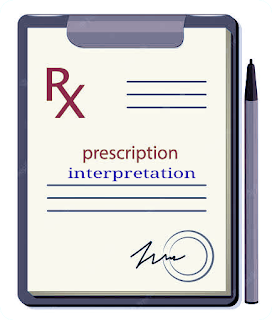Prescription is an order for medication issued by a physician, dentist, or other properly licensed medical practitioner.
Prescriptions are usually written on preprinted forms containing the traditional symbol "Rx" (meaning "recipe," "take thou," or "you take"), name, address, telephone number, and other information regarding the physician or other prescriber.
Interpretation of prescription or medication order is important for proper compounding and dispensing of medicines.
List of Abbreviations Used in Prescription
- po: by mouth (or orally)
- susp: suspension
- pm: as needed
- tab: tablet
- IM: intramuscularly
- IV: intravenous
- cap: capsule
- q: every
- bid: twice a day
- tid: three times a day
- qid: four times a day
- qhs: before bed
- ac: before meals
- pc: after meals
- prn: as needed
- sig.: let it be labeled
- dtd: such doses
- gtt.: drops
- o.d: right eye
- o.l: left eye
Examples of prescriptions written in the metric system
1.
Acetylsalicylic Acid 4.0 g
Phenacetin 0.8 g
Codeine Sulfate 0.5 g
Mix and make capsules no. 20
Sig. One capsule every 4 hours.
2.
Dextromethorphan 0 18
Guaifenesin Syrup 1 2
Alcohol 2 1
Flavored Syrup ad 60 0
Sig. 5 mL as needed for cough.
Related: Pharmaceutical Calculation for Pharm D Students
Specific recommendations to help reduce medication errors
- Spell out "units" (e.g., use 100 units and not 100 u or 100 U since an illegible "U" may he misread as a zero resulting in a tenfold error).
- Certain abbreviations which may be mistaken for other abbreviations should be written out (e.g., write "right eye" or "left eye" rather than use o.d. or o.l.).
- Amplify the preserver's directions on the prescription label when needed for clarity (e.g., use "Swallow one (1) capsule with water in the morning" rather than "one cap in a.m.").
Examples of Prescription Directions to the Pharmacist
1. M. ft. ungt.
Mix and make an ointment.
2. Ft. supp. no xii
Make 12 suppositories.
3. M. ft. cap. d.t.d. no. xxiv
Mix and make capsules. Give 24 such doses.
Examples of Prescription Directions to the Patient
1. Caps. i. q.i.d. p.c. et h.s.
Take one (1) capsule four (4) times a day after each meal and at bedtime.
2. gtt, ii o.d. q.d. a.m.
Instill two (2) drops in the right eye every day in the morning.
3. tab. ii stat tab. 1 q. 6 h. X 7 d.
Take two (2) tablets immediately, then take one (1) tablet every 6 hours for 7 days.
Example 1
Penicillin V Potassium Oral Solution 125 mg/5 mL
Disp. ______mL
Sig. 5 mL q6h ATC X 10 d
How many milliliters of medicine should be dispensed?
Answer: 5 mL 4 times per day (q6h = 6 hourly) equals 20 mL per day for 10 (days) equals 200 mL.
Example 2
What is the percent compliance rate if a patient received a 30-day supply of medicine and returned in 40 days for a refill?
% Compliance = 30/44 × 100% = 75%
Patient compliance with prescribed and non-prescribed medications
It is defined as patient understanding and adherence to the directions for use. The compliant patient follows the label directions for taking the medication properly and adheres to any special instructions provided by the prescriber and/or pharmacist.


إرسال تعليق